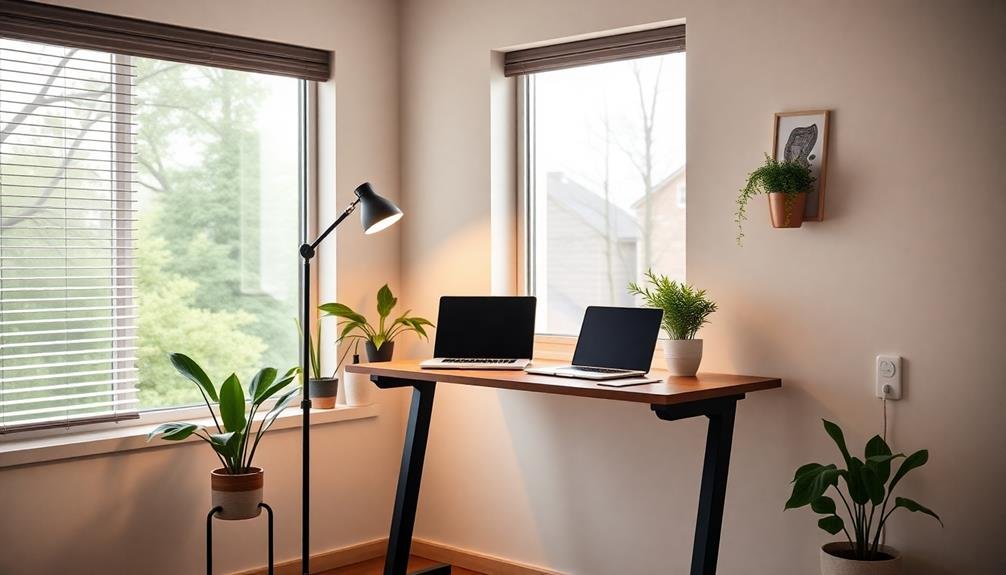You can create three energy-efficient DIY desk setups to boost your telecommuting experience. First, consider a Solar Panel Laptop Charging Station, which harnesses sunlight to power your devices. Next, try a Wind-Powered Standing Desk System that converts wind energy into electricity while promoting better posture. Finally, explore a Pedal-Generated Energy Workstation that combines exercise with work, powering your gadgets as you pedal. These eco-friendly options reduce your carbon footprint, lower electricity bills, and provide reliable power during outages. By implementing these innovative setups, you'll transform your workspace into a sustainable, productive environment. Discover how these solutions can revolutionize your remote work routine.
Solar Panel Laptop Charging Station

One of the most efficient ways to power your laptop while working from home is by creating a solar panel charging station. This eco-friendly setup can greatly reduce your energy consumption and lower your electricity bills.
To build your own, you'll need a solar panel, a charge controller, a battery, and an inverter.
Start by selecting a solar panel with sufficient wattage to charge your laptop. A 50-100W panel is typically adequate for most laptops. Connect the panel to a charge controller, which regulates the voltage and current flowing to the battery. Choose a deep-cycle battery to store the solar energy, ensuring it has enough capacity to power your laptop throughout the day.
Next, connect an inverter to the battery to convert DC power to AC, which your laptop can use. Mount the solar panel in a sunny spot, ideally on your roof or in your yard. Run the cables through a window to your desk, where you can set up a dedicated charging area.
This DIY solar charging station not only reduces your carbon footprint but also provides a reliable power source during outages or when working outdoors.
Wind-Powered Standing Desk System
While solar power offers a great renewable energy option for your desk setup, wind power presents another innovative solution for eco-conscious remote workers. You can create a wind-powered standing desk system using a small wind turbine connected to a battery pack. This setup allows you to harness wind energy and convert it into electricity to power your devices.
To build this system, you'll need a compact wind turbine, a charge controller, a deep-cycle battery, and an inverter. Mount the turbine on your roof or in an open area with consistent wind flow. Connect it to the charge controller, which regulates the power input to the battery.
The deep-cycle battery stores the energy, while the inverter converts DC power to AC for your devices. You can integrate this wind power system with a motorized standing desk, allowing you to adjust your work position throughout the day using renewable energy.
This setup not only reduces your carbon footprint but also promotes better posture and health. Remember to check local regulations before installing a wind turbine and guarantee proper safety measures are in place.
Pedal-Generated Energy Workstation

Pedal your way to a greener workspace with a pedal-generated energy workstation. This innovative setup combines exercise with energy production, allowing you to power your devices while staying active during your workday.
To create this system, you'll need a bicycle generator, a power inverter, and a battery bank. Mount the generator to a sturdy frame and connect it to your existing desk chair or a stationary bike. As you pedal, the generator produces electricity, which is then stored in the battery bank.
The power inverter converts the stored DC power to AC, making it compatible with your electronic devices. You can directly power your laptop, monitor, and other small appliances through this system.
Customize your setup by adding a display to track your energy production and calories burned. This motivates you to keep pedaling and helps you monitor your daily activity levels.
Remember to choose a comfortable seat and maintain proper ergonomics while pedaling. Start with short sessions and gradually increase your pedaling time to avoid fatigue.
With this eco-friendly workstation, you'll reduce your carbon footprint, improve your fitness, and boost your productivity all at once.
Frequently Asked Questions
How Can I Estimate the Energy Savings From My DIY Desk Setup?
You can estimate energy savings by tracking your power usage before and after implementing your DIY desk setup. Use a power meter to measure consumption of individual devices, and compare your monthly energy bills for overall savings.
Are There Any Safety Concerns When Using DIY Energy-Generating Desk Setups?
You should be cautious with DIY energy-generating desk setups. Guarantee proper wiring, avoid overloading circuits, and use surge protectors. Be careful with moving parts, and don't place liquids near electrical components. Always follow safety guidelines and consult professionals when needed.
What Tools Are Necessary for Building These Energy-Efficient Desk Setups?
You'll need basic tools like a drill, screwdriver, and measuring tape. Don't forget safety gear such as goggles and gloves. For energy-efficient features, you might require a soldering iron, wire cutters, and multimeter.
Can These DIY Setups Be Easily Disassembled for Moving or Relocation?
You'll find most DIY setups can be easily disassembled for moving. They're often designed with modularity in mind. Use screws and bolts instead of nails, and opt for lightweight materials. This way, you'll have no trouble relocating your workspace.
Are There Any Government Incentives for Implementing Energy-Efficient Home Office Solutions?
You'll find some government incentives for energy-efficient home offices. Check your local and state programs for tax credits, rebates, or grants. They often cover energy-saving appliances, lighting, and insulation. Federal incentives may also be available for certain upgrades.
In Summary
You've now got three innovative, energy-efficient DIY desk setups to choose from. Whether you're harnessing the sun's power, utilizing wind energy, or generating electricity through pedaling, you're taking a step towards a greener home office. These options not only reduce your carbon footprint but also add a unique touch to your workspace. By implementing one of these eco-friendly solutions, you're contributing to a more sustainable future while enhancing your telecommuting experience.





Leave a Reply